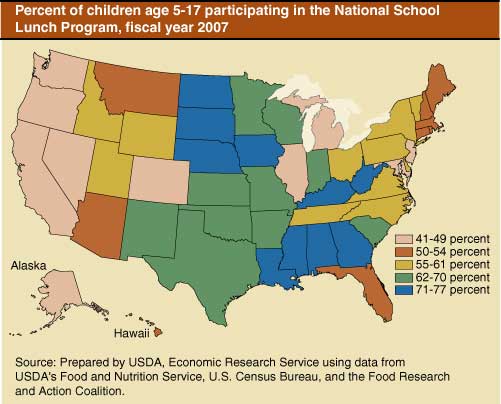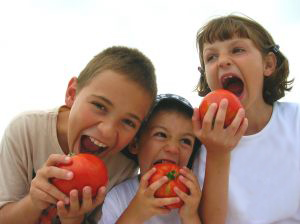The week of August 10 is Healthy Back to School Week at DietsInReview.com.
 Chef Ann Cooper, also known as the Renegade Lunch Lady, has she’s made it her life’s mission to reform the way our children eat, and are fed, at school. Which is why we’re thrilled she’s a part of this special series. At ChefAnn.com, they say “She works to transform cafeterias into culinary classrooms for students — one school lunch at a time.”
Chef Ann Cooper, also known as the Renegade Lunch Lady, has she’s made it her life’s mission to reform the way our children eat, and are fed, at school. Which is why we’re thrilled she’s a part of this special series. At ChefAnn.com, they say “She works to transform cafeterias into culinary classrooms for students — one school lunch at a time.”
Yesterday, Chef Ann spoke about the National School Lunch Program Needing a Makeover. Her commentary continues now.
As for my team and I, we’d like to be spending all of our time and money feeding children delicious healthy food and educating them on where their food comes from and how it’s produced. To make this happen, the NSLP truly needs a makeover!
I believe that the following guidelines, if put into place, would help us focus on feeding children “real,” healthy and delicious food.
- Make meals, both breakfast and lunch, a system where every child is fed every day. This would alleviate the need for free and reduced applications and tracking.
- Replace the current system of tracking menus by nutrients, to one where the guidelines are based on healthy, delicious balanced meals. These meals should be made up in large part of fresh fruits, fresh vegetables, whole grains and include plant-based protein.
- Replace the definition of nutritious food, which the system is based on; to one that defines and is based on real FOOD (see full definition below).
 Raise the federal reimbursement rate to $4.00 – $5.00 based on the cost of living of the area and dedicate a minimum of $1.75 to be spent on food. Additionally, dedicate at least $1.00 be spent on fresh fruits, fresh vegetables and whole grains with a priority placed on procuring regionally produced food.
Raise the federal reimbursement rate to $4.00 – $5.00 based on the cost of living of the area and dedicate a minimum of $1.75 to be spent on food. Additionally, dedicate at least $1.00 be spent on fresh fruits, fresh vegetables and whole grains with a priority placed on procuring regionally produced food.
- Dedicate resources to building and/or rebuilding kitchens in school districts to accommodate scratch cooking.
- Dedicate resources to set-up a training program to teach school food service workers to cook from scratch.
- Set-up a National Chefs Corp which allows culinary students to work off student loans by working in K-12 schools.
- Institute hands-on experiential learning in the form of cooking and gardening classes that become a mandatory part of the educational system.
- Dedicate resources to a national marketing campaign to help change children’s relationships to food, so that healthy/delicious school food – becomes cool food.
- Underscore the importance of eating healthy food by instituting questions on the SAT tests that highlight sustainable food and agriculture.
This may seem like an incredible task given the size of the system and the immensity of the challenges – but I did say it was a makeover that was needed. However, the alternative is unthinkable. The CDC has stated that of the children born in the year 2000, one out of every 3 Caucasians and one out of every 2 African Americans and Hispanics will contract diabetes in their lifetime – the result: the first generation in our country’s history to die at a younger age than their parents.
With the first African American family in the White House, with the achievement and life-expectancy gap (based on the have and the have-nots) ever widening – I believe that this is the Social Justice issue of our time and that we have a moral imperative to take on this seemingly Herculian task.
 In the end, if successful, we will assure the health of all children for generations to come and we just might save the planet in the bargain.
In the end, if successful, we will assure the health of all children for generations to come and we just might save the planet in the bargain.
HEALTHFUL FOOD PRINCIPLES
- Healthful Food is wholesome.
- It includes whole and minimally processed fruits, vegetables, whole grains, legumes, nuts, seeds, eggs, dairy, meats, fish, and poultry.
- It contains naturally occurring nutrients (e.g., vitamins, minerals, phyto-nutrients).
- It is produced without added hormones or antibiotics.
- It is processed without artificial colors or flavors or unnecessary preservatives.
- Healthful Food is produced, processed, and transported in a way that prevents the exploitation of farmers, workers, and natural resources, and the cruel treatment of animals.
The process of healthful food production:
- Upholds the safety and quality of life of all who work to feed us.
- Treats all animals humanely.
- Protects the finite resources of soil, water, air, and biological diversity.
- Supports local and regional farm and food economies.
- Replaces fossil fuels with renewable energy sources.
Healthful Food should be available, accessible, and affordable to everyone.
- Distributed equitably among all communities.
- Available and emphasized in children’s environments such as childcare, school, and after-school settings.
- Promoted within institutions and workplaces, in cafeterias, vending machines, and at meetings and events.
- Reflective of the natural diversity found in traditions and cultures.
(From Prevention Institute)
